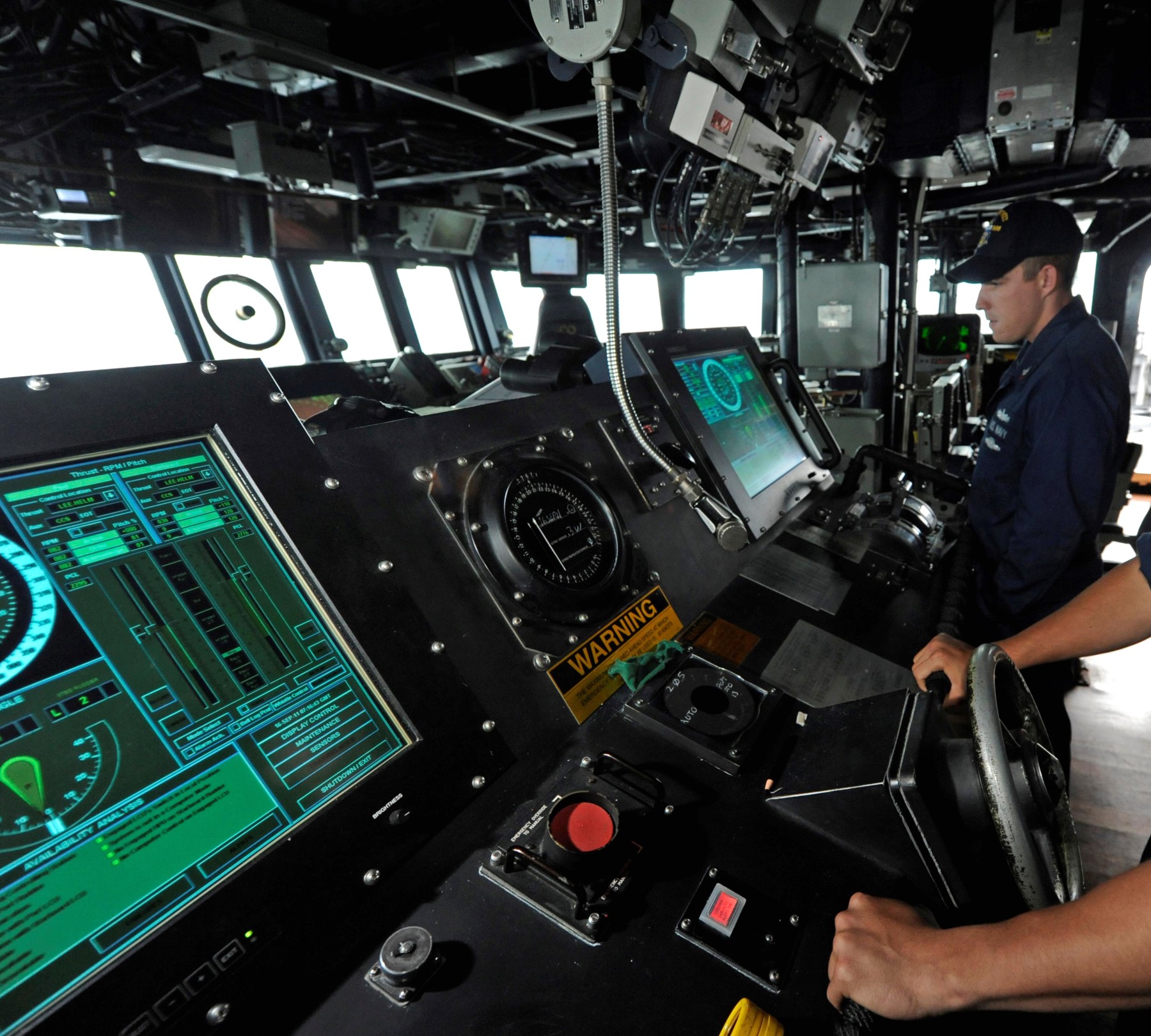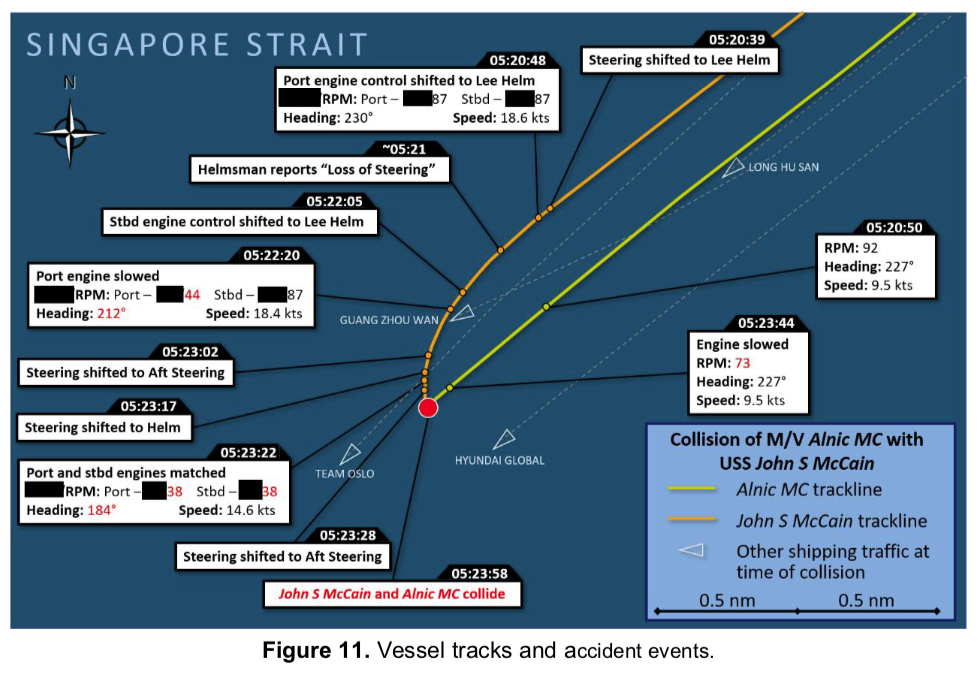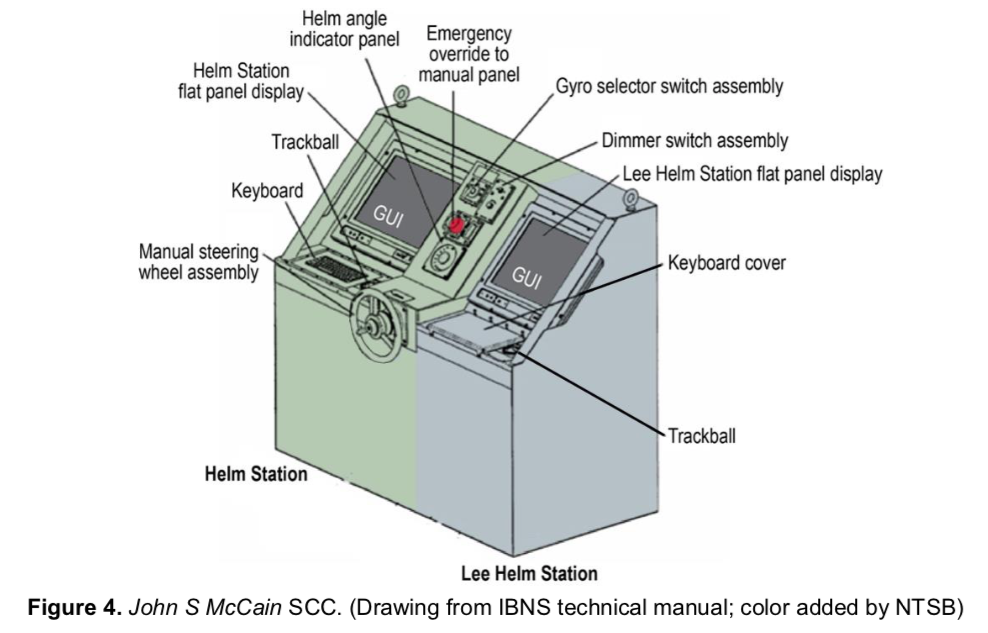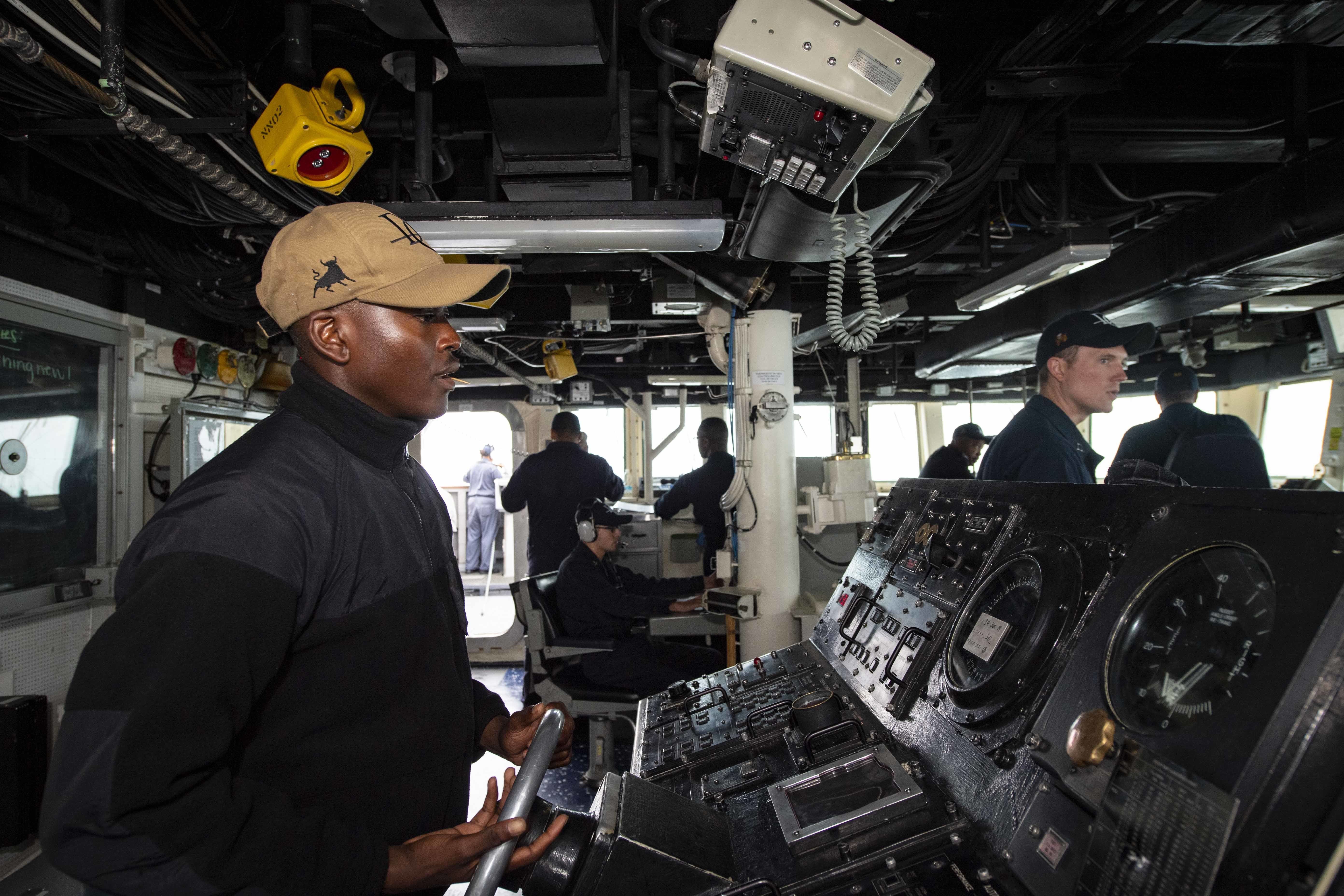IBNS helm controls on USS Dewey (DDG-105).
Touch-Screens are not always ideal in certain work environments.
Designers should note.
US Navy Photo
US Navy Photo
From USNI news by Megan Eckstein
The Navy will begin reverting destroyers back to a physical throttle and traditional helm control system in the next 18 to 24 months, after the fleet overwhelmingly said they prefer mechanical controls to touchscreen systems in the aftermath of the fatal USS John S. McCain (DDG-56) collision.
Damage to the left side is visible as the destroyer USS John S. McCain steers towards Changi Naval Base, Singapore, following a collision with a merchant vessel on Aug. 21, 2017.
The Navy is replacing touch-screen throttles and helms on destroyers with hand-held ones after determining that the McCain's controls caused confusion that contributed to the collision.
Joshua Fulton / U.S. Navy
Joshua Fulton / U.S. Navy
The investigation into the collision showed that a touchscreen system that was complex and that sailors had been poorly trained to use contributed to a loss of control of the ship just before it crossed paths with a merchant ship in the Singapore Strait.
After the Navy released a Comprehensive Review related to the McCain and the USS Fitzgerald (DDG-62) collisions, Naval Sea Systems Command conducted fleet surveys regarding some of the engineering recommendations, Program Executive Officer for Ships Rear Adm. Bill Galinis said.
USS Fitzgerald returning to Yokosuka, Japan, after the collision
Picture: US Navy
“When we started getting the feedback from the fleet from the Comprehensive Review effort – it was SEA 21 (NAVSEA’s surface ship lifecycle management organization) that kind of took the lead on doing some fleet surveys and whatnot – it was really eye-opening.
And it goes into the, in my mind, ‘just because you can doesn’t mean you should’ category.
We really made the helm control system, specifically on the [DDG] 51 class, just overly complex, with the touch screens under glass and all this kind of stuff,” Galinis said during a keynote speech at the American Society of Naval Engineers’ annual Fleet Maintenance and Modernization Symposium.
“So as part of that, we actually stood up an organization within Team Ships to get after bridge commonality.”
NTSB Image
Galinis said that bridge design is something that shipbuilders have a lot of say in, as it’s not covered by any particular specification that the Navy requires builders to follow.
As a result of innovation and a desire to incorporate new technology, “we got away from the physical throttles, and that was probably the number-one feedback from the fleet – they said, just give us the throttles that we can use.”
Galinis told USNI News after his speech that “we’re already in the contracting process, and it’s going to come on almost as a kit that’s relatively easy to install.
[NAVSEA] would do it – it’s not something that the ship would do – but it doesn’t need to be done during a CNO availability, we think it could be done during a smaller one.
Obviously, we have to work our way through that, but that’s the vision.”
In total, the NTSB found seven safety issues associated with the crash.
Safety issues identified in this accident include the following:
Safety issues identified in this accident include the following:
- The decision to transfer the location of thrust control on board the John S McCain while the vessel was in a congested waterway
- The lack of very high frequency radio communications between the vessels
- The automatic identification system data transmission policy for Navy vessels
- The procedures for the transfers of steering and thrust control on board the John S McCain
- The training of Navy bridge watchstanders
- The design of the destroyer’s Integrated Bridge and Navigation System
- Navy watchstanders’ fatigue
NTSB Image with Navy redactions
NAVSEA spokeswoman Colleen O’Rourke told USNI News that “the Navy is designing and planning to install physical throttles on all DDG-51 class ships with the Integrated Bridge and Navigation System (IBNS), the ship control console with the touch-screen throttle control.
The first throttle installation is scheduled for summer of 2020, after the hardware and software changes have been developed and fully tested to ensure the new configuration is safe, effective, and has training in place.
The first in-service ship planned to receive the install is DDG-61; the first new construction ship planned to receive the install is DDG-128.
A contract award to support these efforts is planned for this fiscal year.”
During a later panel, Galinis said that PEO Ships is also looking at variance in bridge designs and systems within ship classes – primarily the LHA/LHD amphibious assault ships, and to a lesser extent the LPD-17 amphibious transport docks – but he added that PEO Ships isn’t trying to achieve fleet-wide commonality at this time.
“Where we do have some variance (within ship classes) and what changes we should make to improve the functionality of standing bridge” are the focus of this ongoing engineering effort, he said.
NTSB Image
Also during the panel, Navy chief engineer and NAVSEA deputy commander for ship design, integration and engineering Rear Adm. Lorin Selby said that the move to achieve greater commonality is not just limited to where helm control systems are installed in the bridge, but how functions appear on the screens of the control systems, and anything else that would contribute to confusion for a sailor moving from one ship to another within the same class.
“When you look at a screen, where do you find heading?
Is it in the same place, or do you have to hunt every time you go to a different screen?
So the more commonality we can drive into these kind of human-machine interfaces, the better it is for the operator to quickly pick up what the situational awareness is, whatever aspect he’s looking at, whether it’s helm control, radar pictures, whatever.
So we’re trying to drive that,” Selby said.
He added that NAVSEA meets once a month to talk about progress on any of the hundreds of recommendations that came out of the Comprehensive Review and the related Strategic Readiness Review that touch NAVSEA.
That progress is reported up from NAVSEA to the vice chief of naval operations, who is overseeing monitoring progress implementing CR and SRR recommendations.
Some of the recommendations will require more substantive changes to address, such as the helm control system backfit effort.
Others are much simpler but just require the thought by engineers to make sure ship operators have access to systems they need in an intuitive way.
Seaman Joseph Brown mans an older verison of helm controls on the bridge of USS Donald Cook (DDG-75) on July 25, 2019.
US Navy Photo
John Pope, the executive director for the program executive office for command, control, communications, computers and intelligence (C4I), said the ships have a laptop in the bridge that runs the Automatic Identification System (AIS) receiver.
Ship crews have, in the aftermath of the Fitzgerald and McCain collisions, complained that the laptops have a finicky connection to the ship via cables, and that they are located behind other gear and hard to access, and other issues that should be easy to address now that there’s a discussion about simplifying the user experience in the bridge.
“We’re going back and relocating that whole configuration– it’s easy to walk a laptop aboard, but how do you make sure that it’s being used right, configured correctly, and a sailor can rely on that?” Pope said.
“So that’s something we picked up out of the Comprehensive Review.”
Links :
- USNI news : NTSB: Lack of Navy Oversight, Training Were Primary Causes of Fatal McCain Collision
- Naval technology : US Navy to replace touchscreens with mechanical controls
- The Verge : The US Navy will replace its touchscreen controls with mechanical ones on its destroyers
- BBC news : US Navy to ditch touch screen ship controls
- Gizmodo : Report on 2017 Destroyer Crash Prompts Navy to Ditch Touchscreen ...
- The Maritime Executive : NTSB Releases Its Analysis of the USS John S McCain Collision
- Business Insider : New report shows crew of the USS John S. McCain weren't trained to ...







No comments:
Post a Comment